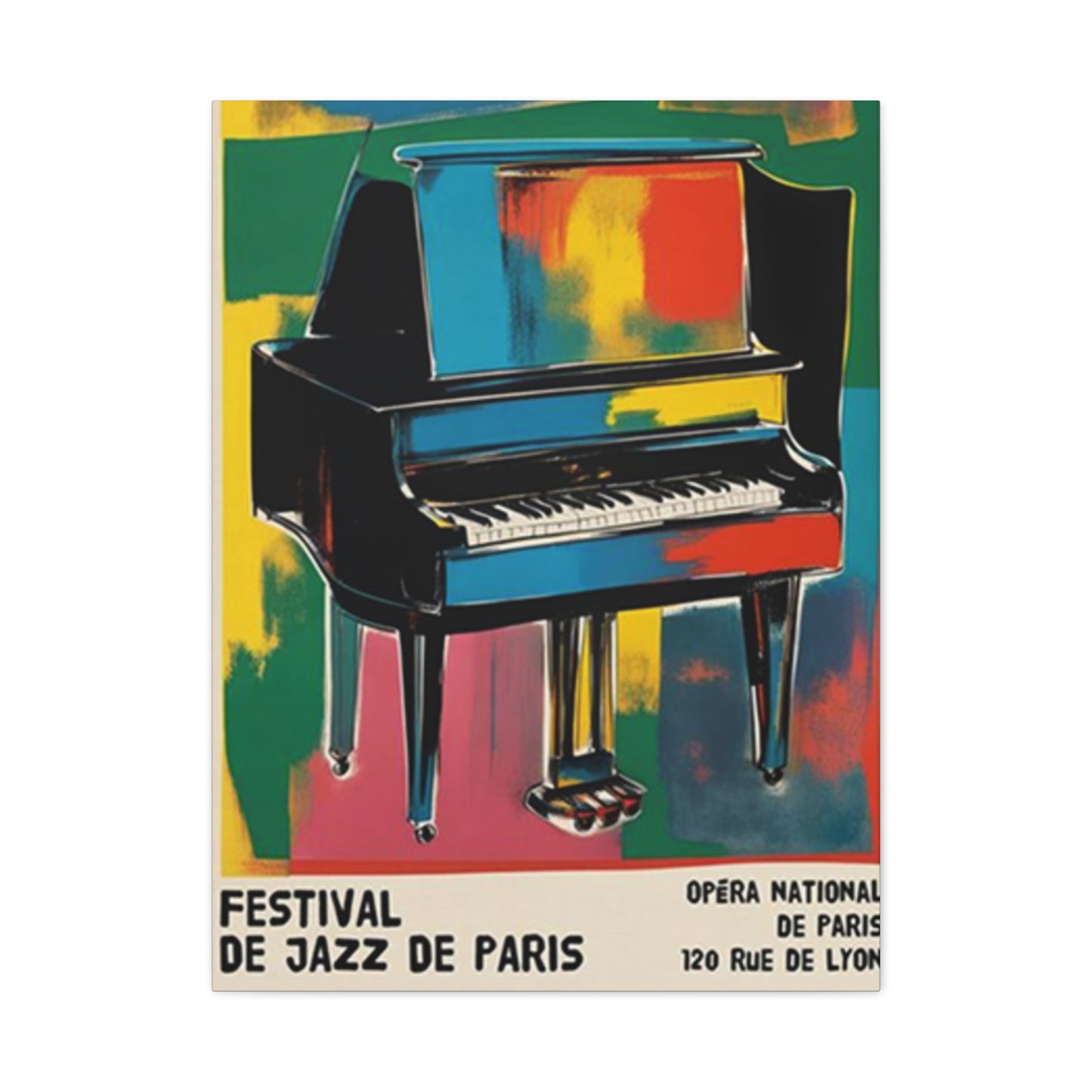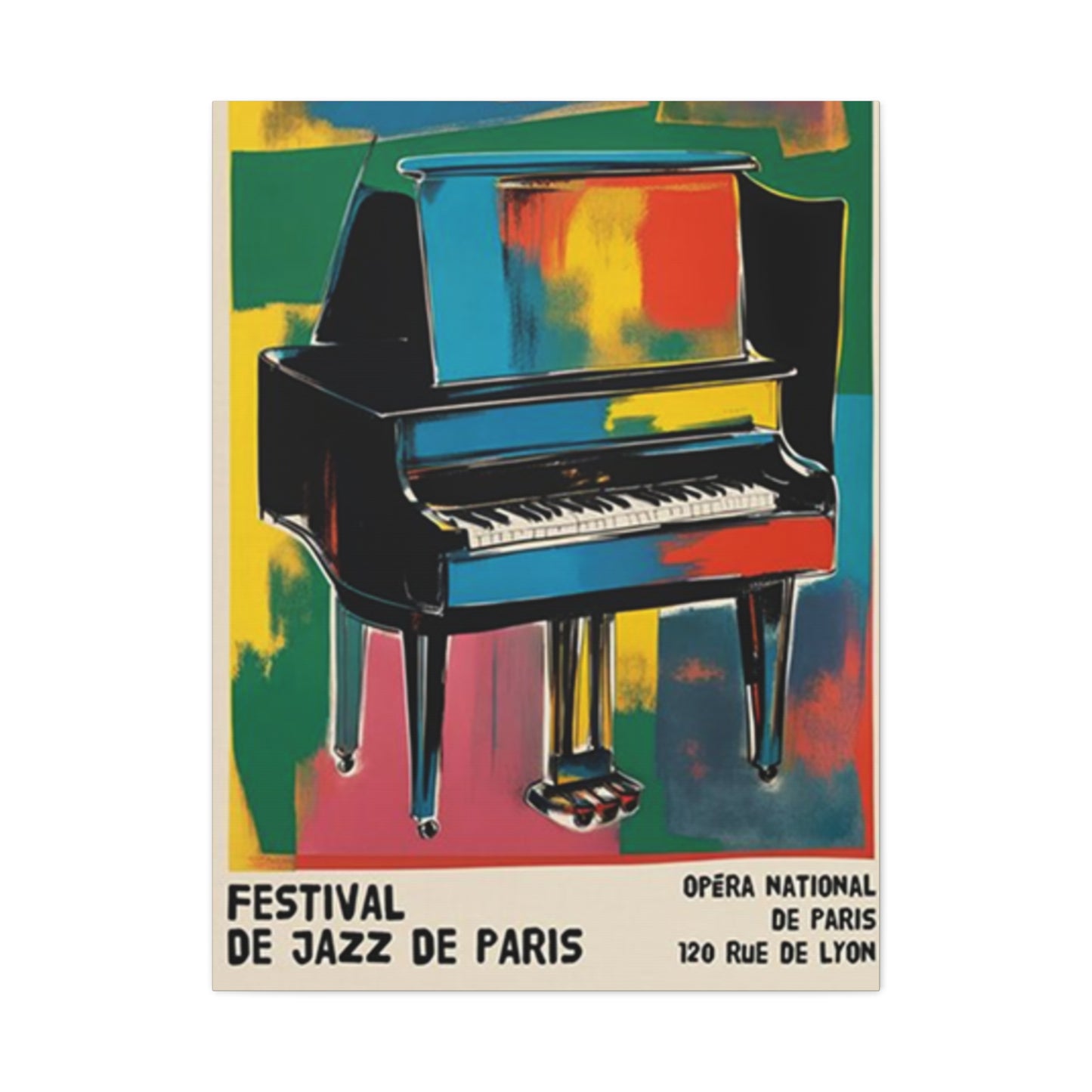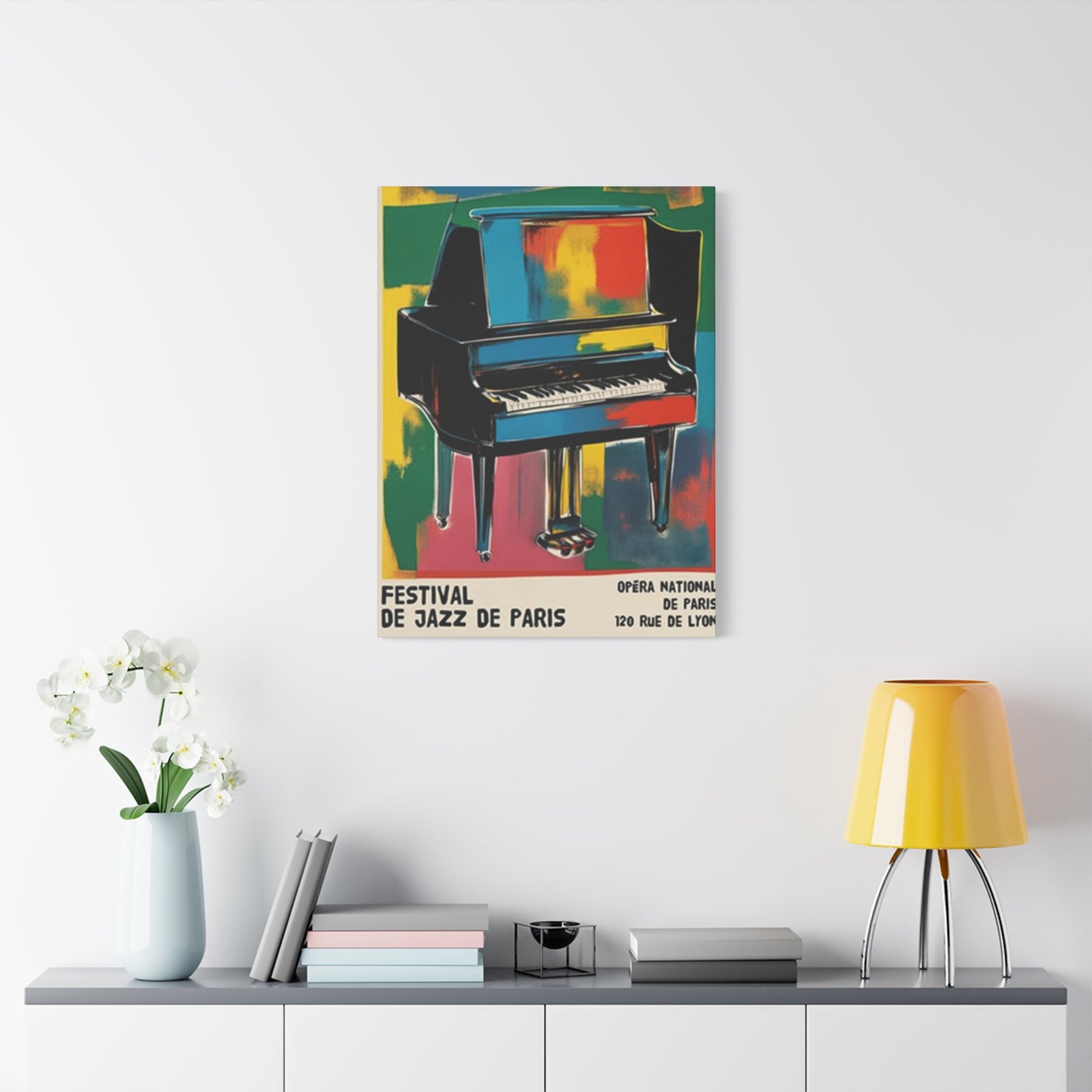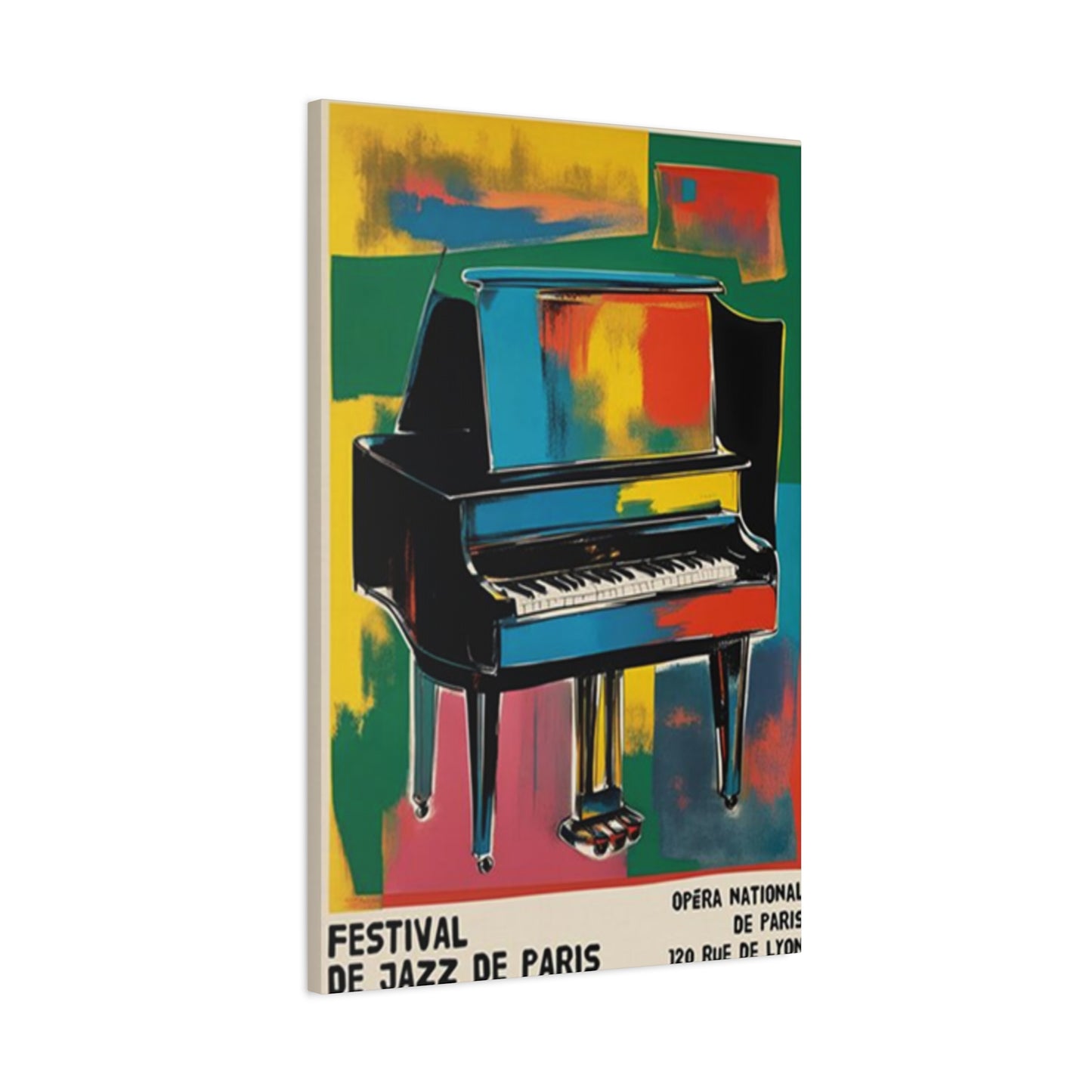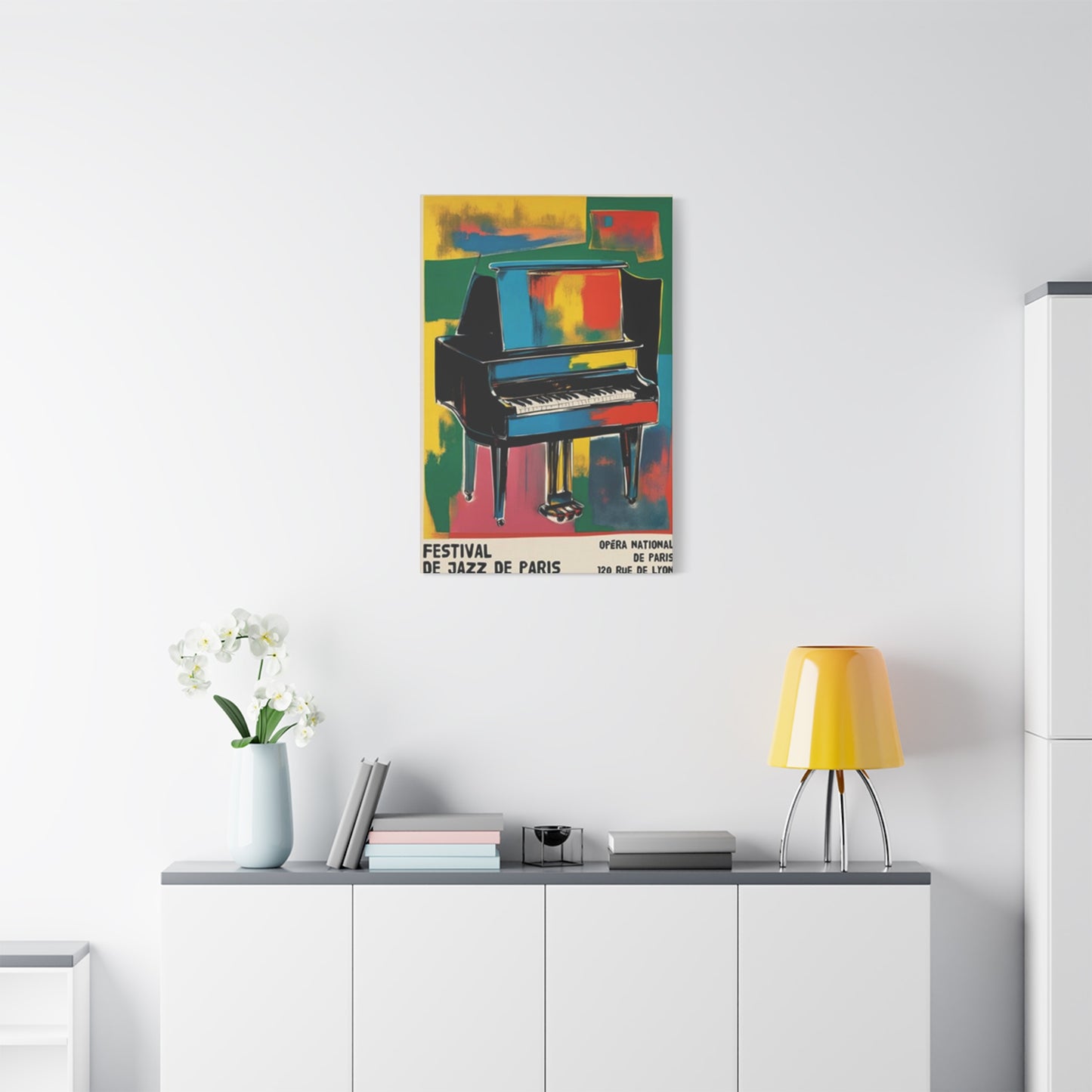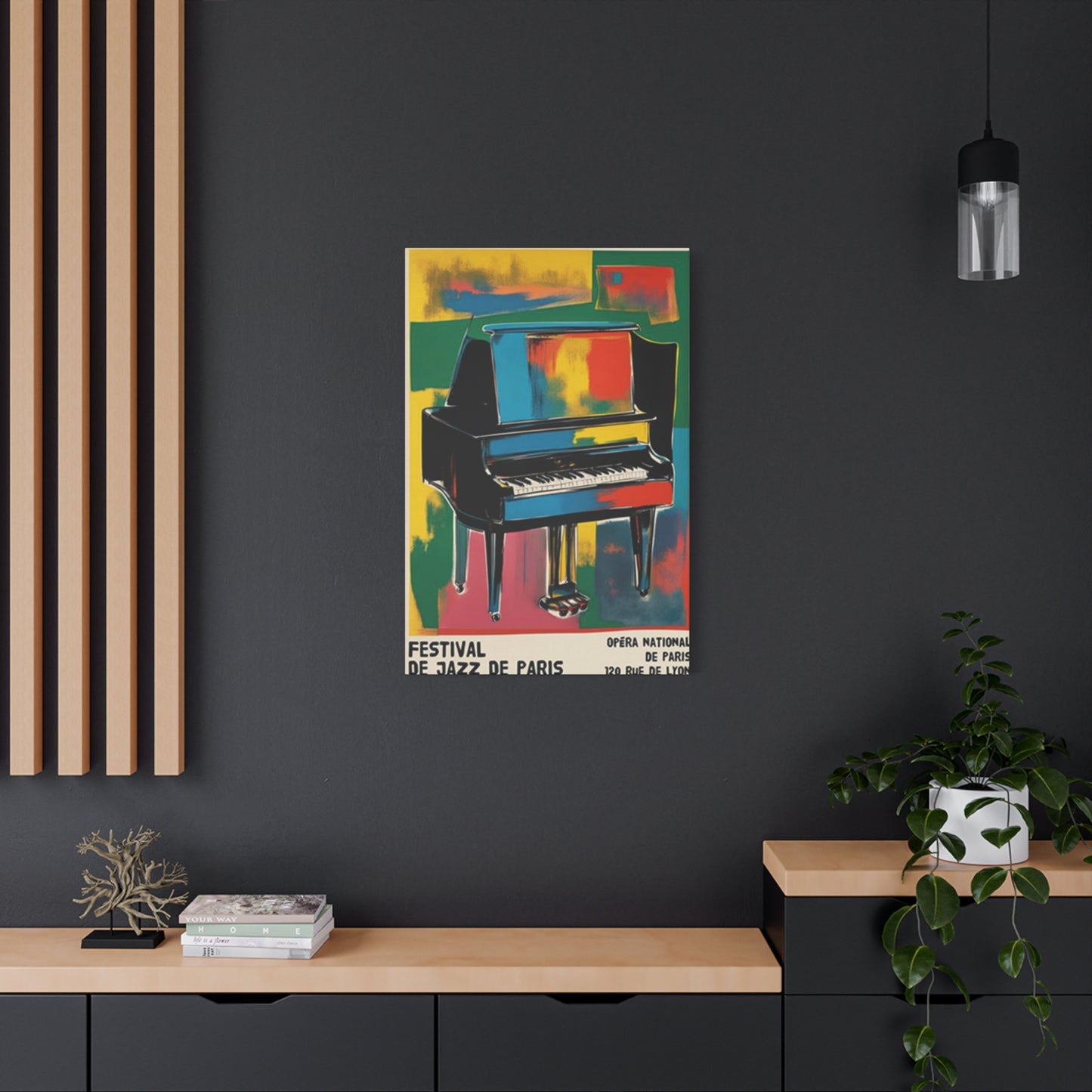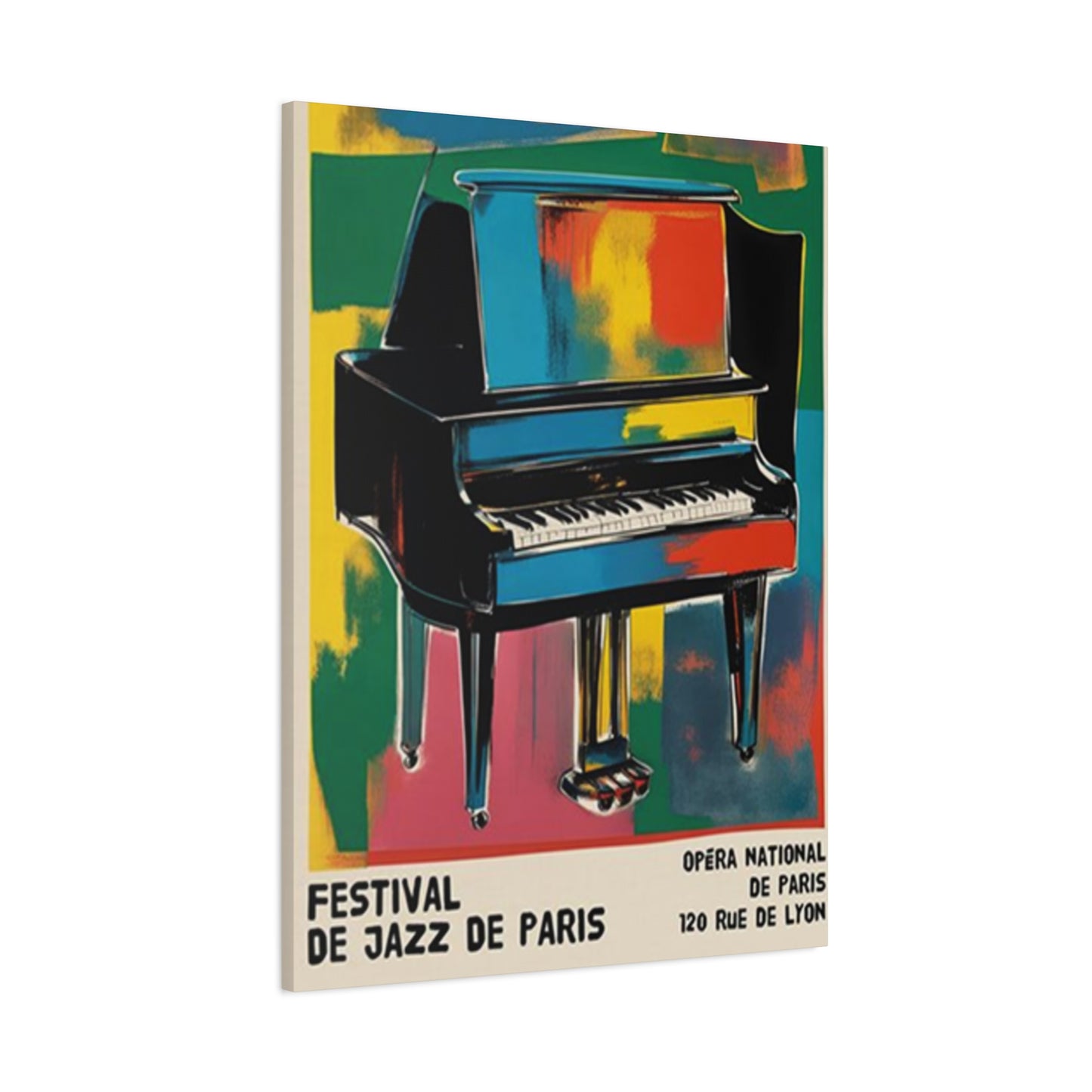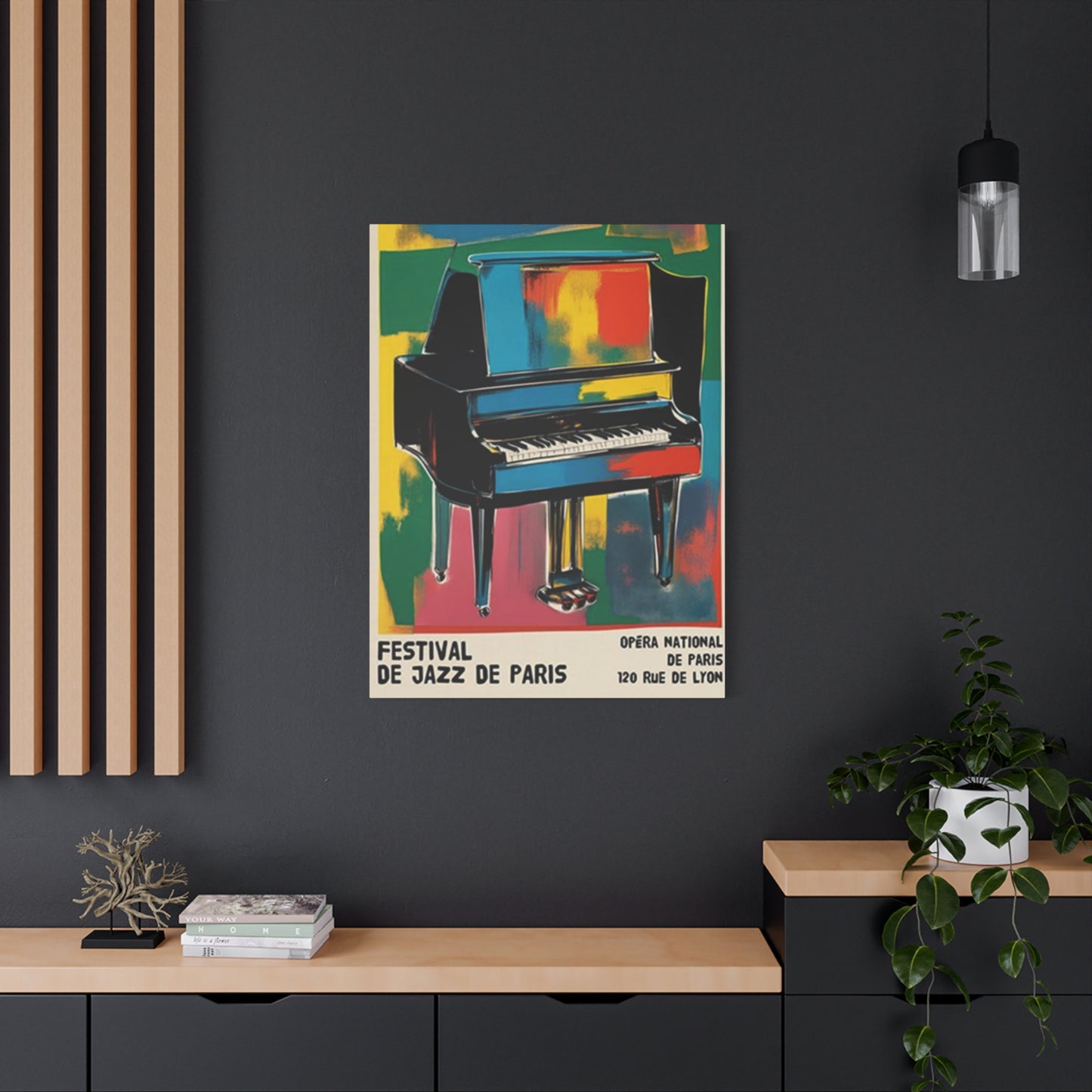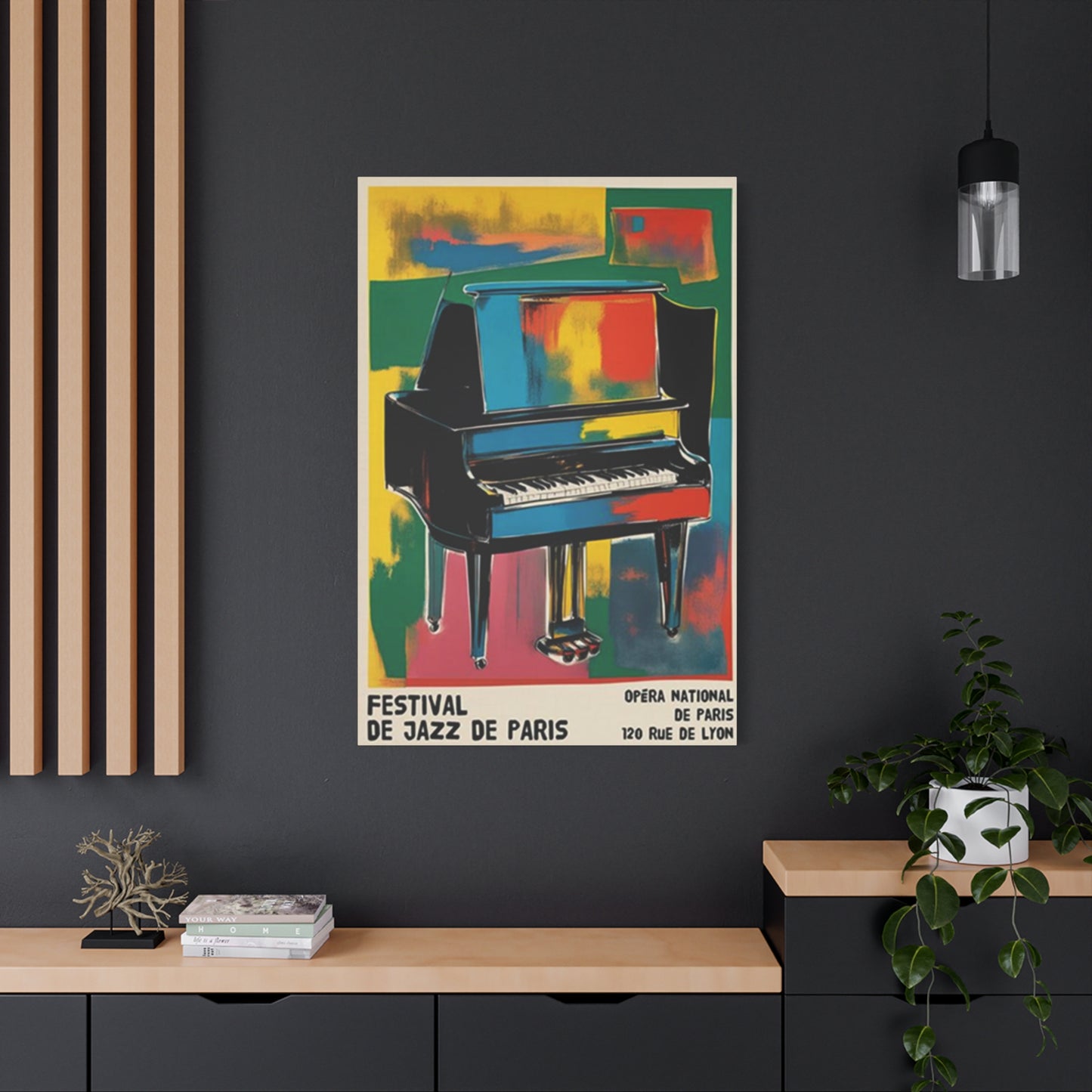Capturing Parisian Rhythms: Festival de Jazz Wall Art for Music Enthusiasts
The allure of Parisian jazz culture has captivated music lovers worldwide, and now this enchanting musical heritage finds its way into home decor through stunning wall art. Festival de Jazz de Paris wall art represents more than mere decoration; it embodies the soul of musical expression, the sophistication of French culture, and the timeless appeal of jazz artistry. These artistic pieces serve as windows into the vibrant world of Parisian jazz festivals, allowing enthusiasts to bring the energy, passion, and elegance of this musical tradition into their living environments.
Musicians, art collectors, and cultural enthusiasts have discovered that incorporating jazz festival artwork into their homes creates an atmosphere that celebrates both visual and auditory artistry. The Festival de Jazz de Paris has become synonymous with exceptional musical performances, cultural diversity, and artistic innovation, making its associated artwork highly sought after by those who appreciate the finer aspects of cultural expression. This form of wall art transcends traditional boundaries, offering viewers a glimpse into the rich tapestry of Parisian musical culture while serving as a constant reminder of the transformative power of jazz music.
The Magnetic Appeal of Parisian Jazz in Wall Art
Parisian jazz culture possesses an undeniable magnetism that draws people from all walks of life, and this attraction extends naturally to the visual representations of jazz festivals. The Festival de Jazz de Paris wall art captures the essence of musical spontaneity, creative expression, and cultural sophistication that defines the Parisian jazz scene. These artistic pieces reflect the dynamic energy that permeates jazz venues throughout Paris, from intimate clubs in Montmartre to grand concert halls hosting international festivals.
The visual language of jazz-inspired wall art communicates emotions that resonate deeply with viewers, regardless of their musical background. Bold colors, flowing lines, and abstract compositions mirror the improvisational nature of jazz music, creating a visual symphony that complements the auditory experience. Artists who create Festival de Jazz de Paris wall art often draw inspiration from iconic jazz musicians, memorable performances, and the unique atmosphere that surrounds these musical celebrations.
Contemporary artists and vintage poster designers alike have contributed to the rich collection of jazz festival artwork, each bringing their unique perspective to the representation of Parisian jazz culture. The diversity of artistic styles ensures that Festival de Jazz de Paris wall art appeals to various aesthetic preferences, from minimalist modern approaches to elaborate vintage designs that harken back to the golden age of jazz publicity.
The cultural significance of these artistic pieces extends beyond their decorative value, serving as historical documents that preserve the legacy of jazz festivals and their impact on Parisian culture. Each poster, print, or artistic interpretation tells a story of musical innovation, cultural exchange, and artistic collaboration that defines the Festival de Jazz de Paris experience.
Festival de Jazz de Paris: Music-Inspired Artistic Excellence
The Festival de Jazz de Paris stands as a beacon of musical excellence, attracting world-renowned artists and passionate audiences to celebrate the art of jazz music. This prestigious event has inspired countless artistic interpretations, resulting in a diverse collection of wall art that captures the festival's essence and energy. The artistic representations of this festival encompass various mediums, styles, and approaches, each contributing to the visual narrative of Parisian jazz culture.
Music-inspired artwork derived from the Festival de Jazz de Paris often features iconic imagery associated with jazz performance: silhouettes of musicians, abstract representations of musical instruments, and dynamic compositions that suggest movement and rhythm. These visual elements combine to create artwork that resonates with both music enthusiasts and art lovers, bridging the gap between auditory and visual artistic expression.
The collaborative nature of jazz music finds its parallel in the creation of festival artwork, where designers, illustrators, and artists work together to produce pieces that accurately represent the spirit of the Festival de Jazz de Paris. This collaborative approach ensures that the resulting wall art maintains authenticity while appealing to diverse artistic tastes and preferences.
Festival organizers have historically commissioned talented artists to create promotional materials, posters, and commemorative artwork that captures the unique character of each year's festival. These commissioned pieces have become highly collectible, representing not only artistic achievement but also serving as historical markers of the festival's evolution and growth over the years.
The influence of the Festival de Jazz de Paris extends far beyond the duration of the actual event, inspiring year-round artistic creation and cultural appreciation. Wall art inspired by this festival serves as a permanent reminder of the transformative power of jazz music and its ability to bring people together in celebration of artistic expression and cultural diversity.
Decorating with Festival de Jazz de Paris Prints
Incorporating Festival de Jazz de Paris prints into home decor requires thoughtful consideration of artistic composition, color coordination, and thematic consistency. These prints offer versatility in decorating applications, suitable for various room types and decorative styles while maintaining their distinctive character and cultural significance. The key to successfully decorating with jazz festival prints lies in understanding how these artistic pieces interact with existing decor elements and architectural features.
Living rooms provide an ideal setting for showcasing Festival de Jazz de Paris prints, particularly when arranged as part of a gallery wall or as a focal point above seating areas. The conversational nature of these artistic pieces makes them perfect for social environments where guests can appreciate both the visual appeal and cultural significance of the artwork. Proper lighting enhances the visual impact of jazz festival prints, with track lighting or picture lights highlighting the intricate details and color variations that make each piece unique.
Bedrooms benefit from the sophisticated ambiance created by jazz festival artwork, with carefully selected prints contributing to a relaxing yet culturally enriched environment. The calming influence of artistic expression combines with the energetic spirit of jazz culture to create a balanced atmospheric effect that promotes both rest and inspiration. Size considerations become particularly important in bedroom applications, with smaller prints working well in intimate settings while larger pieces can serve as dramatic focal points.
Home offices and study areas gain character and inspiration from Festival de Jazz de Paris prints, creating an environment that encourages creativity and cultural appreciation. The intellectual aspects of jazz music, including improvisation, collaboration, and artistic innovation, align well with professional and creative pursuits, making these prints excellent choices for work environments.
Dining areas present unique opportunities for displaying jazz festival artwork, as the social nature of both dining and jazz music creates natural thematic connections. The sophisticated atmosphere created by these prints enhances the dining experience while providing conversation starters for guests who appreciate music and cultural arts. Proper placement ensures that artwork remains visible and appreciated without interfering with dining activities or creating visual distractions during meals.
Jazz Festival Posters: Parisian Edition Characteristics
Jazz festival posters from Paris represent a unique category of artistic expression that combines promotional functionality with artistic merit. These posters have evolved from simple informational announcements to sophisticated artistic statements that capture the essence of jazz culture while serving their promotional purposes. The Parisian edition of jazz festival posters demonstrates distinctive characteristics that set them apart from festival artwork created in other locations around the world.
Typography plays a crucial role in Parisian jazz festival posters, with designers often incorporating elegant fonts that reflect the sophistication associated with French culture. The choice of typefaces ranges from classic serif fonts that evoke traditional elegance to modern sans-serif options that suggest contemporary innovation. The integration of text and imagery in these posters creates cohesive compositions that communicate event information while maintaining artistic integrity and visual appeal.
Color palettes used in Parisian jazz festival posters often reflect both the energy of jazz music and the refined aesthetic sensibilities associated with French artistic traditions. Rich blues, warm earth tones, and sophisticated color combinations create visual harmony while suggesting the emotional depth and complexity of jazz music. The strategic use of color helps these posters stand out in urban environments while maintaining the artistic sophistication expected from Parisian cultural events.
Compositional elements in these posters frequently incorporate architectural features unique to Paris, creating connections between the musical content and the physical environment where festivals take place. Recognizable landmarks, characteristic Parisian street scenes, and architectural details serve as contextual elements that ground the artistic content in its geographic and cultural setting. This integration of location-specific imagery enhances the authentic Parisian character of the festival artwork.
The artistic techniques employed in creating these posters range from traditional illustration methods to contemporary digital design approaches. Many artists combine multiple techniques to achieve unique visual effects that capture the dynamic nature of jazz performance while maintaining the polished appearance expected from professional festival promotion. The resulting diversity in artistic approaches ensures that each year's festival posters offer something new while maintaining thematic consistency with previous years' designs.
Historical influences appear throughout Parisian jazz festival poster design, with many artists drawing inspiration from the rich tradition of French poster art, including the work of famous poster artists from earlier eras. This historical awareness creates continuity between contemporary festival promotion and the broader tradition of French graphic design, adding depth and cultural significance to modern jazz festival artwork.
Adding Rhythm with Festival de Jazz Wall Art
The concept of visual rhythm in Festival de Jazz wall art mirrors the musical rhythms that define jazz performance, creating artwork that seems to pulse with energy and movement even in static form. Artists achieve this sense of rhythm through various design techniques, including repetitive patterns, flowing lines, and dynamic compositions that suggest the improvisational nature of jazz music. The successful integration of rhythmic elements in jazz festival wall art creates pieces that resonate with viewers on both visual and emotional levels.
Compositional rhythm in jazz-inspired artwork often relies on the strategic placement of visual elements that create movement patterns across the artwork surface. These patterns guide the viewer's eye through the composition in ways that parallel the musical phrases and rhythmic patterns found in jazz performance. The careful balance of visual weights, color intensities, and directional elements creates a sense of musical timing that enhances the overall impact of the artwork.
Color rhythm represents another important aspect of Festival de Jazz wall art, with artists using color transitions, contrasts, and harmonies to create visual beats that correspond to musical rhythms. The strategic use of warm and cool colors, light and dark values, and saturated and muted tones creates visual percussion that adds depth and complexity to the artistic composition. This sophisticated approach to color usage demonstrates the high level of artistic skill required to successfully translate musical concepts into visual form.
Linear elements in jazz festival artwork often incorporate flowing, curved lines that suggest the melodic contours and rhythmic patterns characteristic of jazz music. These lines may represent musical instruments, abstract musical notation, or purely decorative elements that add to the overall rhythmic feeling of the composition. The variation in line weight, direction, and curvature creates visual interest while maintaining the sense of musical flow that defines successful jazz-inspired artwork.
Textural elements contribute to the rhythmic quality of Festival de Jazz wall art through the strategic use of surface variations that create visual interest and tactile appeal. Artists may incorporate techniques such as layering, distressing, or mixed media applications to achieve textural effects that suggest the complex layering of sounds found in jazz ensemble performance. These textural variations add depth and sophistication to the artwork while enhancing its ability to capture the essence of jazz musical expression.
The psychological impact of rhythmic visual elements in jazz festival artwork cannot be understated, as these elements trigger emotional responses that connect viewers to the musical content even when no actual music is present. This powerful connection between visual rhythm and musical memory makes Festival de Jazz wall art particularly effective at creating atmospheric effects that enhance the cultural and emotional environment of any room where it is displayed.
Celebrating Jazz Culture Through Paris Festival Art
Jazz culture represents far more than musical performance; it embodies a philosophy of creative expression, cultural exchange, and artistic innovation that finds perfect expression in Festival de Jazz de Paris artwork. These artistic pieces serve as celebrations of the values, traditions, and creative spirit that define jazz culture while honoring the specific contribution of Paris to the global jazz community. The cultural celebration aspect of this artwork extends beyond mere decoration to become a form of cultural preservation and promotion.
The multicultural nature of jazz music finds reflection in the diverse artistic styles and cultural influences present in Paris festival artwork. Artists from various backgrounds contribute their unique perspectives to the visual representation of jazz culture, creating a rich tapestry of artistic expression that mirrors the diversity found in jazz music itself. This multicultural approach ensures that Festival de Jazz de Paris wall art remains relevant and appealing to audiences from different cultural backgrounds and artistic preferences.
Historical awareness plays a crucial role in jazz culture celebration through festival artwork, with many pieces incorporating references to legendary jazz musicians, significant historical events, and important cultural developments that shaped the evolution of jazz music. These historical references serve educational purposes while honoring the legacy of jazz pioneers who contributed to the development of this uniquely American musical form and its international expansion, particularly in Paris.
The social aspects of jazz culture receive attention in festival artwork through compositions that suggest community, collaboration, and shared musical experience. Images of audiences, ensemble performances, and cultural gatherings capture the social dimension of jazz music that makes it more than individual artistic expression. This social element of jazz culture resonates with viewers who understand music as a communal activity that brings people together across cultural and social boundaries.
Innovation and creativity, fundamental aspects of jazz culture, find expression in the experimental approaches and artistic techniques employed by creators of Festival de Jazz de Paris wall art. The willingness to push boundaries, explore new artistic territories, and challenge conventional approaches mirrors the innovative spirit that drives jazz musical development. This creative fearlessness ensures that jazz festival artwork remains dynamic and evolving rather than becoming static or formulaic.
The intellectual aspects of jazz culture, including complex harmonic structures, sophisticated rhythmic patterns, and advanced improvisational techniques, translate into visual elements that demonstrate artistic sophistication and cultural depth. Festival de Jazz de Paris wall art often incorporates subtle references to musical theory, compositional techniques, and performance practices that reward careful observation and cultural knowledge while remaining accessible to viewers without specialized musical background.
Festival de Jazz de Paris Art for Music Lovers
Music lovers represent a specialized audience for Festival de Jazz de Paris wall art, bringing deep appreciation for musical culture and sophisticated understanding of jazz artistic traditions to their evaluation of visual artwork. These discerning collectors and enthusiasts seek artwork that demonstrates authentic connection to jazz culture while maintaining high standards of artistic execution and cultural accuracy. The specific needs and preferences of music lover audiences influence both the creation and marketing of jazz festival artwork.
Authenticity becomes paramount when creating artwork for music lover audiences, as these individuals possess the knowledge and experience necessary to distinguish between genuine artistic expression and superficial commercial imitation. Artists creating Festival de Jazz de Paris wall art for music lovers must demonstrate deep understanding of jazz culture, musical traditions, and the specific characteristics that define authentic jazz artistic expression. This requirement for authenticity drives creators to invest significant time and effort in research, cultural immersion, and artistic development.
Technical musical references in jazz festival artwork appeal particularly to music lover audiences who appreciate subtle nods to musical theory, instrument techniques, and performance practices. These references may include visual representations of complex chord structures, rhythmic patterns, or improvisation techniques that demonstrate the artist's musical knowledge while adding layers of meaning for knowledgeable viewers. The inclusion of such technical elements creates artwork that rewards repeated viewing and deep contemplation.
Emotional resonance represents another crucial factor in creating successful Festival de Jazz de Paris wall art for music lovers, as these audiences seek artwork that captures the passionate, expressive nature of jazz performance. The ability to translate the emotional intensity of live jazz performance into visual form requires significant artistic skill and cultural understanding. Music lovers respond positively to artwork that evokes the feelings and memories associated with powerful jazz musical experiences.
Collecting considerations influence music lover preferences for jazz festival artwork, with many enthusiasts building comprehensive collections that document the evolution of jazz festivals and their artistic representation over time. These collectors often seek limited edition pieces, artist-signed prints, or historically significant posters that hold both artistic and cultural value. The investment potential of high-quality jazz festival artwork adds another dimension to its appeal among serious music lover audiences.
Educational value enhances the appeal of Festival de Jazz de Paris wall art among music lovers who appreciate opportunities to learn about jazz history, cultural development, and artistic evolution through visual materials. Artwork that includes informational elements, historical references, or educational content serves dual purposes as both decorative enhancement and learning resource. This educational aspect particularly appeals to music educators, students, and lifelong learners who value cultural enrichment through artistic appreciation.
Using Jazz Festival Posters to Enhance Your Environment
Jazz festival posters offer unique opportunities to enhance living and working environments through the strategic integration of musical culture and visual artistry. The process of using these posters effectively requires understanding how artistic elements interact with architectural features, existing decor, and intended atmospheric goals. Successful integration of jazz festival posters creates environments that reflect personal interests while contributing to overall aesthetic appeal and cultural sophistication.
Size considerations play a fundamental role in effectively using jazz festival posters to enhance environments, with different poster dimensions serving different decorative purposes and spatial requirements. Large format posters work well as focal points in spacious rooms or as dramatic statements in minimalist settings, while smaller posters integrate more easily into existing decor schemes or work effectively as part of larger artistic arrangements. The relationship between poster size and room scale affects both visual impact and aesthetic balance.
Placement strategies determine the success of jazz festival poster integration, with optimal locations considering viewing angles, lighting conditions, and traffic patterns within the room. Eye-level placement ensures comfortable viewing, while strategic positioning relative to furniture and architectural features creates harmonious relationships between artistic elements and functional room components. The consideration of natural and artificial lighting sources affects both the visibility and preservation of poster artwork over time.
Framing and presentation methods significantly impact the effectiveness of jazz festival posters in environmental enhancement, with appropriate framing techniques protecting the artwork while contributing to overall aesthetic appeal. Professional quality framing with acid-free matting and UV-protective glass ensures long-term preservation while enhancing the visual presentation of the poster content. The choice of frame styles, mat colors, and glass types should complement both the poster artwork and the surrounding decor elements.
Thematic coordination between jazz festival posters and existing environmental elements creates cohesive decorative schemes that enhance rather than compete with other room features. This coordination may involve color matching, stylistic consistency, or cultural theme development that ties the poster content to other decorative elements. The successful achievement of thematic coordination requires careful planning and consideration of how all environmental elements work together to create desired atmospheric effects.
Maintenance and preservation considerations ensure that jazz festival posters continue to enhance environments over extended periods, requiring attention to cleaning, climate control, and protective measures. Regular dusting, appropriate humidity levels, and protection from direct sunlight help preserve poster quality while maintaining their effectiveness as environmental enhancement tools. The implementation of proper maintenance procedures protects both the artistic and financial investment represented by quality jazz festival poster collections.
Paris Jazz Festival Art: A Visual Tribute
Paris jazz festival art serves as a visual tribute to one of the world's most important musical traditions and its unique manifestation in the cultural capital of France. This artistic tribute encompasses multiple dimensions, including historical acknowledgment, cultural celebration, and artistic interpretation of the profound impact that jazz music has had on Parisian culture and international musical development. The tribute aspect of this artwork extends beyond simple representation to become a form of cultural honoring and preservation.
Historical tribute elements in Paris jazz festival art often reference significant events, legendary performers, and important venues that contributed to the development of jazz culture in Paris. These historical references serve as visual reminders of the rich heritage that connects contemporary jazz festivals to the broader story of jazz music's evolution and international expansion. The inclusion of historical elements adds depth and cultural significance to modern jazz festival artwork while educating viewers about important cultural developments.
Artistic tribute techniques employed in creating Paris jazz festival art demonstrate respect for both musical and visual artistic traditions through sophisticated composition, color usage, and technical execution. Artists creating tribute artwork often study historical poster design, jazz photography, and musical iconography to ensure their work maintains appropriate cultural authenticity while expressing contemporary artistic sensibilities. This careful balance between historical respect and contemporary relevance characterizes successful tribute artwork.
Cultural tribute aspects of Paris jazz festival art acknowledge the broader cultural impact of jazz music on Parisian society, including its influence on fashion, literature, visual arts, and social movements. The artwork often incorporates subtle references to these broader cultural connections, creating pieces that celebrate jazz music's role in shaping modern Parisian culture. This comprehensive approach to cultural tribute makes the artwork relevant to audiences interested in various aspects of French cultural history and development.
Personal tribute elements allow individual artists to express their personal connections to jazz music and Parisian culture through their artistic interpretations of festival themes. These personal expressions add emotional authenticity to the artwork while creating connections between artists, subjects, and audiences that enhance the overall impact of the tribute. The inclusion of personal tribute elements ensures that the artwork maintains human scale and emotional resonance despite its cultural and historical significance.
Contemporary tribute approaches in Paris jazz festival art demonstrate how modern artists continue to honor jazz traditions while adapting to current artistic trends and cultural contexts. These contemporary tributes often incorporate digital techniques, modern design sensibilities, and current cultural references while maintaining respect for jazz heritage and Parisian cultural traditions. The evolution of tribute approaches ensures that Paris jazz festival art remains relevant and engaging for contemporary audiences while preserving its essential tribute function.
Festival de Jazz de Paris Artwork and Contemporary Style
The relationship between Festival de Jazz de Paris artwork and contemporary style represents a dynamic intersection where traditional jazz culture meets modern design sensibilities and current aesthetic trends. This integration requires careful balance between maintaining the authentic character of jazz festival art while adapting to contemporary visual preferences and decorating approaches. The successful fusion of jazz heritage with contemporary style creates artwork that appeals to modern audiences while preserving cultural integrity and artistic significance.
Contemporary color palettes in Festival de Jazz de Paris artwork often incorporate current design trends while maintaining connection to traditional jazz aesthetic elements. Modern color schemes may feature sophisticated neutrals, bold accent colors, or trending color combinations that align with current decorating preferences while preserving the essential character of jazz-inspired art. The strategic use of contemporary color approaches ensures that jazz festival artwork remains relevant in modern decorating contexts without losing its cultural authenticity.
Design minimalism represents one contemporary approach to jazz festival artwork that reduces visual complexity while maintaining essential cultural and artistic elements. This minimalist approach appeals to contemporary audiences who prefer clean, uncluttered visual presentations while still celebrating jazz culture through carefully selected iconic elements. The challenge of minimalist jazz artwork lies in maintaining cultural significance while reducing visual information to its most essential components.
Digital artistic techniques enable contemporary artists to create Festival de Jazz de Paris artwork that incorporates modern production methods while honoring traditional jazz artistic traditions. Digital tools allow for sophisticated color manipulation, precise compositional control, and creative effects that enhance the visual impact of jazz festival artwork. The integration of digital techniques with traditional jazz imagery creates contemporary pieces that maintain cultural relevance while demonstrating modern artistic capabilities.
Contemporary typography approaches in jazz festival artwork reflect current design trends while maintaining readability and cultural appropriateness. Modern font selections, creative text arrangements, and innovative typographic treatments add contemporary appeal to jazz festival artwork without compromising its informational or cultural functions. The successful integration of contemporary typography requires understanding both current design trends and the specific communicative requirements of jazz festival promotion.
Mixed media applications represent contemporary approaches to creating Festival de Jazz de Paris artwork that combines traditional artistic techniques with modern materials and methods. These mixed media pieces may incorporate photography, digital elements, traditional illustration, and various textural components to create complex, layered compositions that reflect the sophisticated nature of both jazz music and contemporary art. The use of mixed media techniques allows artists to explore new creative territories while maintaining connection to jazz cultural traditions.
Vintage vs. Modern Festival de Jazz Posters
The comparison between vintage and modern Festival de Jazz posters reveals fascinating differences in artistic approach, cultural context, and aesthetic sensibilities that reflect the evolution of both jazz culture and graphic design over several decades. These differences provide insight into changing artistic trends, technological developments, and cultural attitudes while highlighting the enduring appeal of jazz festival artwork across different historical periods. Understanding these distinctions helps collectors, decorators, and cultural enthusiasts make informed choices about incorporating jazz festival posters into their environments.
Vintage Festival de Jazz posters typically demonstrate artistic characteristics that reflect the design sensibilities and production limitations of their historical periods. These vintage pieces often feature hand-drawn illustrations, traditional typography, and color palettes that reflect available printing technologies and artistic conventions of their time. The authentic period characteristics of vintage posters contribute to their historical value and appeal among collectors who appreciate genuine artifacts from jazz festival history.
Artistic techniques employed in vintage jazz festival posters often relied on traditional illustration methods, including pen and ink drawing, watercolor painting, and lithographic printing processes that created distinctive visual characteristics. These traditional techniques produced artwork with unique textural qualities, color variations, and artistic imperfections that contribute to their charm and authenticity. The limitation of these traditional techniques often resulted in creative solutions that enhanced rather than hindered the artistic impact of vintage festival posters.
Modern Festival de Jazz posters benefit from contemporary design tools, printing technologies, and artistic techniques that enable greater precision, color accuracy, and creative possibilities. Digital design software allows modern artists to experiment with complex compositions, sophisticated color gradations, and innovative visual effects that were impossible to achieve using traditional methods. These technological advantages enable modern jazz festival posters to achieve high levels of visual sophistication and artistic complexity.
Cultural context differences between vintage and modern jazz festival posters reflect changing social attitudes, musical developments, and artistic trends that influence how jazz culture is perceived and represented. Vintage posters often reflect the social and cultural context of their historical periods, including fashion trends, social attitudes, and cultural references that may seem dated to contemporary viewers. Modern posters incorporate current cultural references, social awareness, and contemporary artistic sensibilities that resonate with today's audiences.
Collectibility factors distinguish vintage and modern Festival de Jazz posters in terms of rarity, historical significance, and investment potential. Vintage posters often command higher prices due to their scarcity, historical importance, and authentic connection to jazz festival history. Modern posters may become collectible based on artistic merit, limited production runs, or the reputation of their creators, but they generally lack the historical significance that drives vintage poster values.
Decorative applications for vintage and modern jazz festival posters serve different aesthetic purposes and appeal to different decorating preferences. Vintage posters contribute historical character, nostalgic appeal, and authentic cultural references that enhance traditional or eclectic decorating schemes. Modern posters offer contemporary visual appeal, current design sophistication, and fresh interpretations of jazz culture that work well in contemporary decorating contexts.
How to Display Festival de Jazz de Paris Wall Art
Displaying Festival de Jazz de Paris wall art effectively requires careful consideration of multiple factors including placement, lighting, protection, and integration with existing decor elements. The goal of proper display techniques is to maximize the visual impact and cultural significance of the artwork while ensuring its long-term preservation and aesthetic integration within the intended environment. Successful display strategies enhance both the artwork itself and the overall atmospheric quality of the surrounding room or gallery.
Wall preparation represents the foundation of effective wall art display, requiring attention to surface conditions, structural support, and protective measures that ensure secure and lasting installation. Proper wall preparation may involve patching holes, applying appropriate paint finishes, and installing adequate hanging hardware that can support the weight and size of the intended artwork. The investment in proper wall preparation prevents future problems while ensuring professional-quality display results.
Height considerations play a crucial role in wall art display effectiveness, with optimal placement typically positioning artwork at eye level for comfortable viewing. The standard eye level height ranges from 57 to 60 inches from floor to center of artwork, though this may vary based on ceiling height, furniture placement, and room usage patterns. Proper height placement ensures that artwork receives appropriate attention while maintaining comfortable viewing conditions for occupants and visitors.
Lighting design significantly impacts the effectiveness of Festival de Jazz de Paris wall art display, with appropriate lighting enhancing visual appeal while protecting artwork from damage caused by excessive exposure or inappropriate light sources. Professional picture lighting, track lighting systems, or strategically placed accent lights can dramatically improve artwork visibility and impact. The choice of light sources should consider both illumination quality and conservation requirements to ensure long-term artwork preservation.
Grouping strategies for multiple pieces of jazz festival artwork require careful planning to create cohesive, balanced arrangements that enhance rather than compete with individual pieces. Effective grouping considers factors such as size relationships, color coordination, thematic connections, and visual weight distribution to create harmonious wall arrangements. The spacing between grouped pieces should maintain individual piece integrity while creating overall compositional unity.
Conservation considerations ensure that Festival de Jazz de Paris wall art remains in good condition throughout its display period, requiring attention to environmental factors such as humidity, temperature, and light exposure. Proper conservation measures may include UV-protective glazing, climate control systems, and regular inspection protocols that identify and address potential preservation issues. The implementation of conservation measures protects both the artistic and financial investment represented by quality jazz festival artwork.
Rotation strategies allow collectors and enthusiasts to enjoy larger collections of Festival de Jazz de Paris wall art while providing rest periods that help preserve individual pieces. Systematic rotation prevents overexposure while maintaining fresh visual interest in displayed artwork. The development of rotation schedules should consider seasonal themes, special events, and conservation requirements while ensuring that valuable pieces receive appropriate display time.
Festival de Jazz de Paris Prints for Music Rooms
Music rooms provide ideal environments for displaying Festival de Jazz de Paris prints, creating thematic coherence between musical activities and visual artistic elements while enhancing the overall cultural atmosphere of these specialized environments. The integration of jazz festival artwork in music rooms requires consideration of acoustic properties, functional requirements, and aesthetic preferences that support both musical performance and visual appreciation. Successful integration creates environments that celebrate musical culture while providing inspiration and cultural enrichment for musicians and listeners.
Acoustic considerations influence the selection and placement of Festival de Jazz de Paris prints in music rooms, as these environments require careful attention to sound quality and acoustic characteristics. The choice of framing materials, glazing options, and mounting methods should minimize acoustic interference while providing appropriate artwork protection and presentation. Glass glazing may create sound reflections that affect acoustic properties, while alternative protective options such as acrylic glazing may offer better acoustic compatibility.
Functional layout requirements in music rooms influence artwork placement decisions, as these environments must accommodate musical instruments, performance areas, and audience seating while maintaining clear sight lines and safe movement patterns. Festival de Jazz de Paris prints should enhance rather than interfere with musical activities while remaining visible and appreciated by room occupants. The coordination between artwork placement and functional requirements ensures that both visual and musical elements contribute positively to the overall room experience.
Thematic coordination between Festival de Jazz de Paris prints and other musical elements in music rooms creates cohesive environments that celebrate jazz culture comprehensively. This coordination may involve selecting artwork that complements specific instruments, musical styles, or performance requirements present in the room. The successful achievement of thematic coordination requires understanding the relationships between visual artistic elements and musical cultural content.
Inspirational value represents a crucial benefit of incorporating Festival de Jazz de Paris prints in music rooms, as these artistic elements can provide motivation, cultural connection, and creative inspiration for musicians and music enthusiasts. The visual reminders of jazz festival culture, musical excellence, and artistic achievement create environments that encourage musical exploration and cultural appreciation. The inspirational impact of jazz festival artwork may enhance both practice sessions and performance experiences.
Educational opportunities arise from displaying Festival de Jazz de Paris prints in music rooms, particularly in educational settings where students can learn about jazz history, cultural development, and artistic interpretation through visual materials. The artwork serves as teaching tools that complement musical instruction while providing cultural context for jazz music study. The educational value of jazz festival prints makes them particularly valuable additions to music education environments.
Maintenance considerations specific to music rooms require attention to the unique environmental conditions present in these specialized environments. Musical activities may generate higher humidity levels, temperature variations, and vibration that could affect artwork preservation. The implementation of appropriate environmental controls and protective measures ensures that Festival de Jazz de Paris prints remain in good condition despite the challenging conditions often present in active music rooms.
The Story Behind Festival de Jazz de Paris Art
The story behind Festival de Jazz de Paris art encompasses multiple narratives including the historical development of jazz festivals in Paris, the evolution of associated artwork, and the cultural significance of visual representations of musical events. Understanding these stories enhances appreciation for jazz festival artwork while providing cultural context that deepens viewer engagement and emotional connection. The narrative aspects of this artwork contribute to its value as both artistic expression and cultural documentation.
Historical origins of Festival de Jazz de Paris art trace back to the early development of jazz culture in Paris and the need to promote musical events through visual communication. The evolution from simple informational announcements to sophisticated artistic expressions reflects both the growth of jazz festivals and the development of graphic design as an artistic discipline. Early festival artwork often featured amateur designs or generic musical imagery, while later developments demonstrated increasing artistic sophistication and cultural awareness.
Artist contributions to Festival de Jazz de Paris art include work by both established artists and emerging talents who brought their unique perspectives to the visual representation of jazz culture. Many renowned graphic designers, illustrators, and artists have contributed to the body of jazz festival artwork, each adding their distinctive style and interpretation to the ongoing visual narrative of Parisian jazz culture. The diversity of artistic contributors ensures rich variety in approaches, techniques, and cultural perspectives represented in festival artwork.
Cultural influences shaping Festival de Jazz de Paris art reflect the multicultural nature of jazz music and the international character of Paris as a cultural center. Artists creating festival artwork often draw inspiration from African-American jazz traditions, French artistic heritage, and international cultural elements that contribute to the unique character of Parisian jazz festivals. This multicultural influence creates artwork that celebrates cultural diversity while maintaining specific connection to Parisian cultural context.
Production stories behind specific pieces of Festival de Jazz de Paris art often involve interesting collaborations between artists, festival organizers, and cultural institutions that shaped the final artistic results. These production stories may include challenges overcome, creative decisions made, and cultural considerations addressed during the artwork creation process. Understanding these behind-the-scenes stories adds depth and human interest to appreciation of the finished artwork.
Evolution patterns in Festival de Jazz de Paris art demonstrate how artistic styles, cultural references, and production techniques have changed over the decades of festival history. This evolution reflects broader changes in graphic design trends, cultural attitudes, and technological capabilities while maintaining essential connections to jazz culture and Parisian artistic traditions. Tracking these evolution patterns provides insight into both art history and cultural development.
Legacy impact of Festival de Jazz de Paris art extends beyond its original promotional purposes to influence contemporary graphic design, cultural representation, and artistic appreciation. Many pieces of festival artwork have become iconic representations of jazz culture that continue to inspire new generations of artists and cultural enthusiasts. The lasting impact of this artwork demonstrates its success in capturing and preserving essential elements of jazz festival culture for future generations.
Bringing Parisian Jazz Festivals to Your Walls
The process of bringing Parisian jazz festivals to your walls through carefully selected artwork creates opportunities to transform living and working environments into celebrations of musical culture and artistic appreciation. This transformation requires thoughtful selection, proper installation, and creative integration of jazz festival artwork that captures the essence of Parisian musical culture while enhancing personal environments. Successful integration creates atmospheric effects that transport viewers to the vibrant world of Parisian jazz festivals regardless of their actual location.
Selection criteria for bringing Parisian jazz festival atmosphere to walls should consider factors such as authenticity, artistic quality, cultural significance, and personal resonance with the intended audience. Authentic pieces that demonstrate genuine connection to actual festivals or Parisian jazz culture provide more meaningful atmospheric effects than generic musical artwork. The selection process should balance personal preferences with cultural authenticity to ensure satisfying long-term appreciation of the chosen artwork.
Atmospheric creation through jazz festival artwork involves understanding how visual elements contribute to overall environmental mood and emotional impact. The colors, compositions, and cultural references present in Festival de Jazz de Paris artwork can influence room atmosphere in subtle but significant ways. Creating an authentic Parisian jazz festival atmosphere requires selecting artwork that captures the sophistication, energy, and cultural richness associated with these musical events.
Scale considerations affect the success of bringing jazz festival atmosphere to walls, with different artwork sizes creating different environmental impacts and atmospheric effects. Large-scale pieces can serve as dramatic focal points that dominate room atmosphere, while smaller pieces may contribute to overall ambiance without overwhelming other environmental elements. The choice of artwork scale should align with both room dimensions and desired atmospheric intensity.
Complementary elements enhance the effectiveness of jazz festival artwork in creating authentic Parisian atmosphere, with supporting decorative elements such as lighting, furniture, and accessories contributing to overall thematic coherence. These complementary elements may include period-appropriate furniture, appropriate lighting design, or cultural artifacts that reinforce the Parisian jazz theme. The coordination of artwork with complementary elements creates more complete and convincing atmospheric effects.
Personal connection development with Parisian jazz festival artwork enhances the long-term satisfaction and atmospheric effectiveness of wall displays. This personal connection may develop through learning about the cultural context, understanding the artistic techniques, or exploring the musical traditions represented in the artwork. Strong personal connections ensure that the atmospheric effects of jazz festival artwork remain meaningful and engaging over extended periods.
Maintenance of atmospheric effects requires ongoing attention to artwork condition, environmental factors, and complementary elements that contribute to overall room atmosphere. Regular cleaning, appropriate environmental controls, and periodic refreshing of complementary elements help maintain the atmospheric impact of jazz festival wall displays. The investment in ongoing maintenance protects both the artwork and the atmospheric effects it creates.
Conclusion
Festival de Jazz wall art captures the vibrant essence of Parisian jazz culture, offering music enthusiasts a unique way to celebrate their passion for this timeless genre. Paris, long considered a global jazz hub, pulses with an energy and elegance that translates beautifully into visual art. From smoky jazz clubs to lively street performances along the Seine, the spirit of the Festival de Jazz is one of rhythm, creativity, and soulful expression—qualities that inspire artists to create stunning wall art that resonates with both musicians and admirers alike.
Incorporating Festival de Jazz-themed artwork into your space does more than just decorate walls; it transforms your environment into a sanctuary of musical inspiration. These pieces often feature iconic imagery—saxophones, trumpets, expressive musicians, and vibrant crowds—rendered in styles ranging from classic vintage posters to modern abstract interpretations. The use of bold colors, dynamic lines, and evocative imagery helps capture the improvisational spirit of jazz itself, making every glance at the artwork feel like a fresh musical note.
What makes Festival de Jazz wall art particularly appealing is its versatility. Whether you’re a seasoned jazz aficionado, a casual listener, or someone who simply appreciates lively, artistic decor, these pieces complement a wide range of interior styles. They bring a sophisticated yet playful flair to living rooms, music studios, cafes, and even office spaces. The art invites viewers to tap into the energy and emotion of jazz, encouraging creativity, relaxation, and a deeper appreciation for the cultural heritage of Paris.
Moreover, Festival de Jazz art pieces often serve as conversation starters. They evoke stories of legendary musicians, historic performances, and the enduring legacy of jazz festivals in Paris. Displaying this art reflects not only a love for music but also a connection to the rich cultural tapestry that jazz weaves through the city’s streets and history. For collectors, these artworks hold a special place as both aesthetic treasures and cultural symbols.
In conclusion, Festival de Jazz wall art is a perfect blend of artistic beauty and musical passion. It offers music lovers a tangible way to celebrate the rhythms, stories, and vibrant atmosphere of Parisian jazz festivals. Whether used to inspire creativity, add character to a space, or honor a beloved genre, this art form invites all who see it to experience the magic of jazz in a new and visually captivating way. Embrace the soulful rhythms of Paris and let Festival de Jazz wall art bring harmony and spirit to your home or workspace.

















